This delicious and healthy Cauliflower Chickpea Curry recipe is perfect for those who want to enjoy a flavorful and comforting meal without spending too much time in the kitchen. Packed with vegetables, fragrant spices, and mouth-watering sauce, this dish is sure to become a go-to favorite for both weeknights and for a special occasion. What's more, this delicious recipe makes the best leftovers because it's even better the next day.

This simple recipe is full of health benefits and flavors guaranteed to satisfy. The combination of creamy coconut milk, savory spices, chickpeas and cauliflower make for one delicious dinner that your family will be asking for again and again. It's easy enough for beginners but tasty enough for experienced chefs— regardless of dietary restrictions or food preferences, everyone can enjoy this delectable meal!
Jump to:
The ingredients

- olive oil or coconut oil
- onion
- cloves garlic
- fresh ginger
- curry powder
- ground cumin
- sweet paprika
- salt
- cauliflower florets
- chickpeas, drained and rinsed
- crushed tomatoes you can also use tomato puree
- full fat coconut milk or 1 cup of heavy cream
- fresh cilantro
See recipe card for quantities
How to prepare the Cauliflower Chickpea Curry, step-by-step with photos

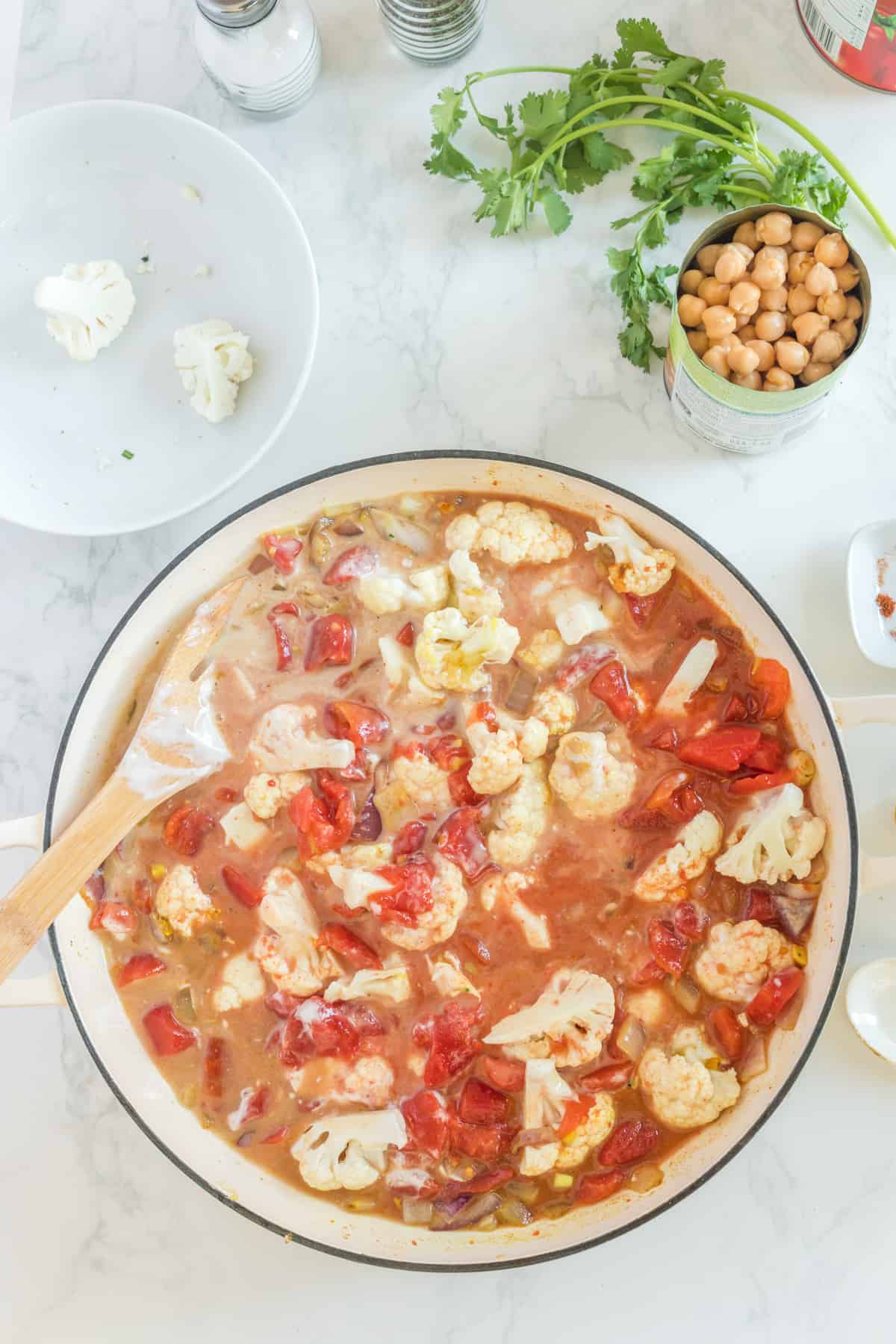
In a large pan or large pot, heat 1 tbsp. of olive oil over medium heat. Add the chopped onion and cook for 4-5 minutes or until translucent.
Add minced garlic and ginger, cooking for another 1-2 minutes until fragrant.
Stir in the curry powder, ground cumin, sweet paprika, and salt. Mix well with the onions, garlic, and ginger, allowing the spices to become aromatic for 2-3 minutes.
Add the cauliflower florets to the skillet and stir well, ensuring they are evenly coated with the spice mixture. Cook for 5 minutes, or until the cauliflower starts to soften.
Add crushed tomatoes, and coconut milk. Mix well, then bring the mixture to a gentle simmer on medium-low heat


Cover and cook for 15-20 minutes, or until the cauliflower is tender, stirring occasionally. Adjust seasoning as needed.
Add the can chickpeas and continue cooking for another 5 minutes

Once the curry is done, remove it from heat and stir in the chopped fresh coriander if desired.
Serve over steamed basmati rice, brown rice, quinoa, or with some warm naan bread.
Optional Garnish
- Pinch of red pepper flakes
- Greek yogurt
- Green onions
Storage
Storing this Cauliflower Chickpea Curry is simple and convenient. After cooking, allow the dish to cool down to room temperature before transferring it to an airtight container. You can store the leftovers in the refrigerator for up to three days, or in the freezer for up to three months.
If freezing the dish, ensure that it is completely cooled down before adding it to a freezer-safe container. You can also divide the dish into smaller portions for your meal prep. When reheating, simply thaw the dish overnight in the refrigerator and reheat on the stovetop or in the microwave until heated through.
It is important to note that the texture of the dish may change slightly after freezing and reheating. However, the flavors of the curry sauce will still be delicious and the dish will remain nutritious. Make sure to label the container with the date you cooked it, so you know when it was made and when it should be consumed. By properly storing this recipe, you can enjoy the flavors and convenience of this curry anytime.
Frequently Asked Questions
Certainly! If you have access to fresh, ripe tomatoes, they can be chopped and added to the recipe with a splash of water or vegetable stock. However, canned tomatoes are preferred for this recipe, as they provide a consistent flavor and texture year-round.
If you prefer a spicier curry, you can adjust the amount of curry powder and sweet paprika to taste, or even 1 teaspoon of hot red curry paste for extra heat.
Yes, frozen cauliflower can be used in place of fresh. For best results, thaw it before adding to the skillet or pot with other ingredients. You may need to adjust the cooking time slightly if using frozen vegetables.
Yes, you can substitute other types of beans for the chickpeas in this recipe. Kidney beans, black beans and cannellini beans are all delicious options that work well with the spices used in this dish. Adjust the cooking time accordingly if using canned or dried beans instead of chickpeas.

Variations
For those who prefer a milder curry, reduce the curry powder to 1 tsp.
For an extra boost of flavor, add 1 tsp. of garam masala. 1 teaspoon chilli powder or 1 teaspoon ground coriander to the sauce
To incorporate more veggies, feel free to add diced carrots, sweet potatoes, bell peppers, red onion, or even spinach, they make a great addition to the curry
Curry and Stew Recipes

Cauliflower Chickpea Curry
Ingredients
- 1 tablespoon olive oil
- 1 onion chopped
- 3 cloves garlic minced
- 1 tablespoon fresh ginger minced
- 1 tablespoon curry powder
- 1 teaspoon ground cumin
- 1 teaspoon sweet paprika
- 1 teaspoon Salt
- 4 cups cauliflower florets
- 1 can 15 oz chickpeas
- 1 can 28 oz crushed tomatoes
- 1 can 14 oz full fat coconut milk
- ¼ cup fresh coriander chopped chopped
Instructions
- In a large pan or large pot, heat 1 tbsp. of olive oil over medium heat. Add the chopped onion and cook for 4-5 minutes or until translucent.
- Add minced garlic and ginger, cooking for another 1-2 minutes until fragrant.
- Stir in the curry powder, ground cumin, sweet paprika, and salt. Mix well with the onions, garlic, and ginger, allowing the spices to become aromatic for 2-3 minutes.
- Add the cauliflower florets to the skillet and stir well, ensuring they are evenly coated with the spice mixture. Cook for 5 minutes, or until the cauliflower starts to soften.
- Stir in the drained and rinsed chickpeas, crushed tomatoes, and coconut milk. Mix well, then bring the mixture to a gentle simmer on medium-low heat.
- Cover and cook for 15-20 minutes, or until the cauliflower is tender, stirring occasionally. Adjust seasoning as needed.
- Once the curry is done, remove it from heat and stir in the chopped fresh coriander if desired.
- Serve over steamed basmati rice, brown rice, quinoa, or with some warm naan bread




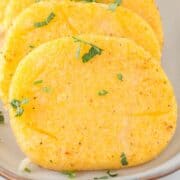





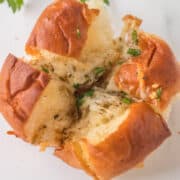



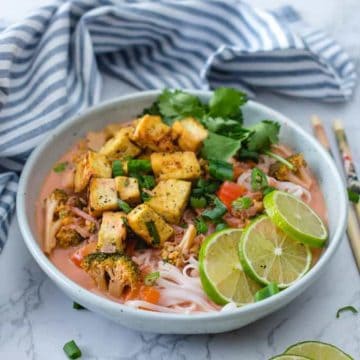





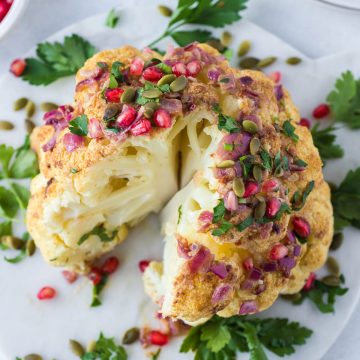
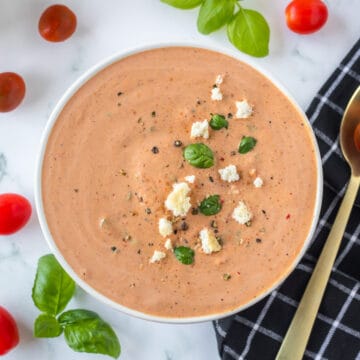
Joëlle Boels
Une recette facile à faire Et délicieusement bonne , j’ai eu du mal à me retenir de vider la casserole 😂😂😂 .
Parfait Merciiiii 👌
Sophie
Merci Joëlle ! Vraiment contente que tu ai aimé 🙂
Sharon
This healthy and flavorful chickpea curry was so easy to make and the perfect dinner for a meatless Monday.
Sophie
Hi Sharon, for sure it's great to have go-to recipes for meatless Mondays or any day of the week when you want a delicious vegetarian option
Kathryn
This cauliflower and chickpea curry was flavorful and this was my first time having curry. I served this with rice and it was a hit. Thanks for sharing!
Sophie
Hi Kathryn, I'm so happy to hear that this cauliflower and chickpea curry was flavorful and that it was a hit, especially since it was your first time trying curry. Serving it with rice is a great choice, as the rice can soak up all the delicious flavors and make it a filling meal.
veenaazmanov
This is definitely a comfort meal. Vegan sounds healthier too. My lunch would be perfect with this Bowl.
Sophie
I'm glad to hear that you find this recipe to be a comforting and healthy vegan option for lunch. It's always great to have a meal that not only satisfies your hunger but also nourishes your body with healthy ingredients. I hope you get a chance to try making this bowl for your lunch
Megane
I love the combo of curry and ginger it is just so flavorsome. The cauliflower and chickpeas go so well with it too. I really enjoyed it as a meal and with some naan.
Sophie
I'm so glad to hear that you enjoyed the combination of curry and ginger in the recipe, as well as the cauliflower and chickpeas. Naan is a great choice to pair with this dish, as it can soak up all the delicious flavors and add a nice texture.
Jessica
This was a great curry - I added the additional garam masala, and my family said it was the best curry I have made for dinner so far! Your recipe for The Win!!
Sophie
I'm so glad to hear that you and your family enjoyed the curry recipe, and that it turned out to be the best one you've made for dinner so far. It's always a great feeling when a recipe is a hit with your loved ones, and I'm honored that my recipe could be a part of that experience for you. Thank you for trying it out and sharing your feedback!
Oana
I absolutely loved this cauliflower chickpea curry recipe! It is seriously bursting with flavor! It's like a party in your mouth with all the spices and seasonings!
Sophie
Thank you Oana! I'm thrilled to hear that you loved the cauliflower chickpea curry recipe and that it turned out to be bursting with flavor. It's always wonderful when a recipe comes together and creates an explosion of taste and texture in your mouth. Thank you for sharing your experience, and I hope you get a chance to make it again soon!
Jamie
Oh my, this curry dish looks very promising and yummy! A unique curry recipe that will be an instant favorite! I just love the color it gives, makes this so enticing and tempting!
Sophie
You're very welcome! It's always great to hear when someone finds a recipe that looks delicious and interesting. Trying out new recipes can be a fun and rewarding experience, and I hope you enjoy this curry soon!
Monica
Love this! I have been making chickpea curry for awhile now but never with the cauliflower - it's the perfect addition to stretch out the meal, add texture, and make it healthier besides. Thanks for the lovely recipe!
Sophie
So happy to hear you’ve been enjoying this curry Monica!
Claire
This curry looks SO delicious! We're always looking for more vegetarian dinner recipes, so I can't wait to give this a try.
Sophie
I'm thrilled to hear that you find this curry recipe so delicious and that you're excited to give it a try!